Menu
-
- Shop
- Glamping Tents
- Wall Tents
- Canvas Tent
- Bell Tents
- Festival Tents
- Hunting Tents
- Yurt Tents
- Family Tents
- Stargazing Tent
- Cabin Tents
- Camping Gifts
- Overland Tents
- Tent Stoves
- 4 Person Tents
- 6 Person Tents
- 8 Person Tents
- 12 Person Tents
- Canvas Bags
- Camp Gears
- Camping Chairs
- Shade Canopy Tents
- Camping Fans
- Resources
- About
- Contact Us
- Reviews
-
- Login

Free Shipping

Pay No Sales Tax
30-Month Warranty
Tents
Shop

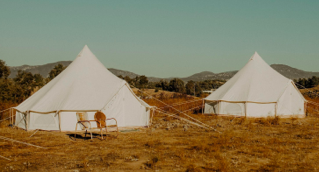
The LiT List
Glamping & Camping Ideas + Resources
The Many Different Styles of Canvas Tents
6 min read
The different styles of canvas tents have exploded. Thanks to the growing popularity of glamping, sustainability, and simply embracing the outdoors, what was once considered the old hand-me-down tent your grandpop couldn’t pay someone to take, has perked the interests of campers and tent manufacturers. Except today, canvas tents have evolved with modern materials, making them the tent of choice for many camping enthusiasts.
In this guide, we explore the many different canvas tent styles and point out what makes each one unique.
The Different Styles of Canvas Tents
Canvas tents offer many benefits: Durability, weather resistance, spaciousness, and well… they’re just plain beautiful. Depending on the style of the canvas tent, you can incorporate wood-burning stoves to create a hot tent or winter hunting tent, or even open up all its windows and raise the side walls to provide maximum breathability.
Let’s explore!
Canvas Bell Tents

Canvas bell tents are easy to spot and named after their elegantly curved cone-shaped design. Commonly used for Airbnb rentals and events, bell tents are a beautiful style of canvas tent perfect for glamping.
A single center pole supports the bell tent structure and when pitched, you have a circular base with vertical walls, which are secured by surrounding stakes (and sometimes outer sidewall supports). Due to the center pole, canvas bell tents hold up well against strong winds and offer standing height toward the tent’s center peak. Along the vertical walls, you will commonly find mesh-screened windows. If you know where to look, you can also find bell tents that allow you to raise the vertical walls for extra breathability and airflow.
Inside, there’s plenty of floor space to go around for your entire crew, which is why canvas bell tents are considered one of the best family camping tents.
Canvas A-Frame Tents

Ask a kid to draw a tent, this is what comes out. Canvas A-frame tents are the classic triangle shape, supported by a pole at each end, which creates a pitched roof. The sloped walls shed rain and the flap door (often one on each end) offers a channel for wind and ventilation.
Canvas military-style pup tents are iconic A-frame tents. However, you can find this style of canvas tent to be relatively compact for backpackers or you can find them larger for families and scout troops. The downside to most A-frame tents is the lack of sidewalls, thus headroom (although Life inTents Scout About is the exception). But while they sit lower to the ground, it offer a streamlined swag-like design that can withstand stormy conditions (if you position them into the wind).
Canvas Ridge Tents
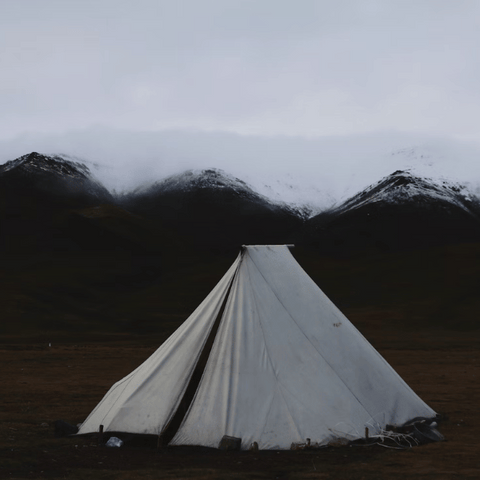
Canvas ridge tents are similar to A-frame tents, except they offer a bit more headroom down the center. Just like canvas A-frame style tents, they have a central ridgepole that runs lengthwise, supported by vertical poles at each end. With this setup, the canvas roof is stretched into a sharp incline that sheds water, making it a great tent for stormy or harsh weather. However, due to the limited guy lines, this style of canvas tent must be pitched and tied down properly.
Canvas Safari Wall Tents
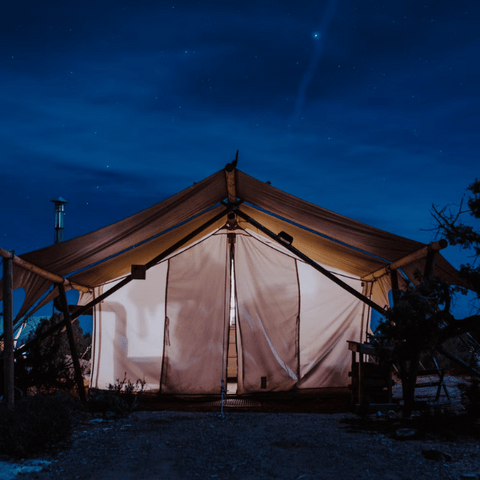
Classic and built for adventure, canvas safari wall tents are steeped in history. This style of canvas wall tent offers substantial vertical walls, which make for a roomy interior, and are often designed with partitions and dividers to create extra rooms for privacy, making for a more luxurious camping setup.
However, a canvas safari wall tent also has a sturdy frame structure, making them pretty rugged. Historically used for long-term camping trips out in the safari wilderness and on hunting trips, these canvas tents are built to withstand the elements and are spacious enough to accommodate a hunting party or an exploration crew.
Canvas Cabin Tents
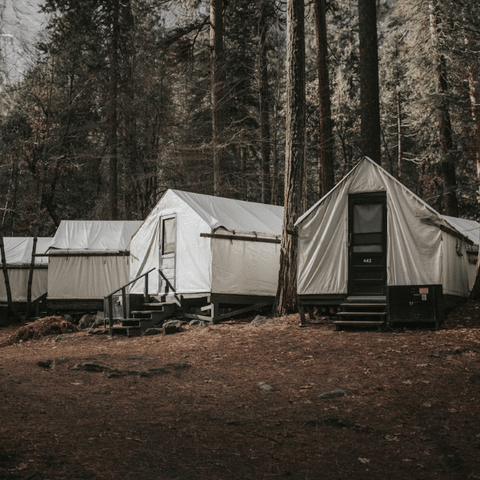
Cabin tents are similar to safari tents, but the key difference often comes down to weight and size. Safari tents can be more spacious, whereas a cabin tent is more boxy. A cabin tent offers an A-frame style roof shape (great for shedding water), and also features taller walls and corner posts vs a traditional camping tent, allowing for windows and making them roomier (except the occasion center post). Canvas cabin tents are like the little brother of wall tents.
Canvas Dome Tents

Canvas dome tents are more rounded in shape, and smaller, like a traditional camping tent. You see a lot of traditional dome tents made of nylon materials and collapsible poles, which means that this style of canvas tents is uncommon – but they do exist! Designed with flexible poles that cross over and support weather-resistant poly-canvas, canvas dome tents are the easiest to transport.
You might ask: what about tunnel tents? Think of tunnel tents as an extended version of the dome tent, with a few additional crossover flexible poles and possibly an exterior rainfly that creates a small porch vestibule.
Canvas Teepee Tents
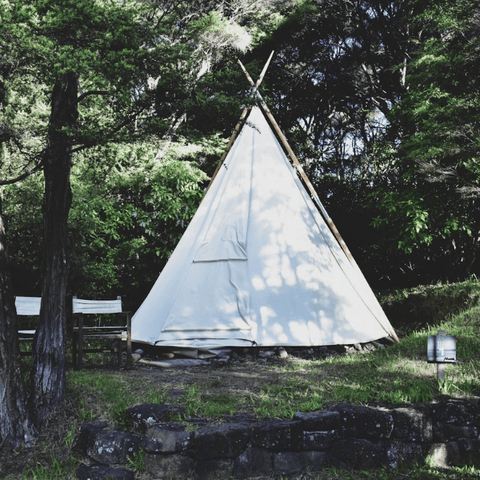
The Indigenous and native teepee tent is historically made of wood poles and buffalo hide. Made even more transportable for nomads of today, teepee tents offer modern features like a sewn-in groundsheet, windows for ventilation, and weather-resistant coated canvas that stretches across its distinctive conical shape, supported by a center pole and side poles. Inside is plenty of floor space, however, its iconic silhouette limits standing room toward the very middle of the tent.
Teepees can vary greatly in size. You can find smaller two-person teepees for a romantic camping getaway to spacious 6-person teepees that can accommodate your entire clan.
Canvas Pyramid Tents

A close cousin to the teepee is the pyramid tent – think the original Sibley legacy that inspired bell tents. The difference is that canvas pyramid tents, while conical in shape, have three to four straight sides. With these flat sides, however, like teepees, pyramid tents lack truly straight vertical walls and headspace. What they do offer instead is the ability to peel back a section or even an entire side, creating a rainfly vestibule for, let’s say, our faithful companions, without letting dirty paws inside.
Even when constructed of canvas, pyramid tents are relatively lightweight, compact and stable, which offers a fantastic tent style for backpackers and solo campers. However, like ridge tents, pyramid tents need to be staked down properly to withstand strong winds and nasty weather.
Canvas Flex-bow Tents

Flex-bow tents feature a semi-rigid frame combined with heavyweight canvas and flexible fiberglass or steel rods. Lacking a center pole, a canvas flex-bow tent bends outward to create a cabin-style design with vertical walls and a peaked roof, which makes for a spacious interior with standing room height.
Flex-bow tents are popular among solo hunters (or a group of hunters looking for privacy). A flex-bow tent's compact size allows you to toss it in a truck bed or haul it into the backcountry by pack mules. Their rugged canvas material and flexible rods frombrands like kodiak canvas and springbar tents, make them durable enough for weekend hunting trips and even as a month-long private “room” at your family deer camp.
Canvas Swag Tents & Bivys

Designed for solo travelers and backpacking campers are canvas swag tents and bivy canvas tents. While these styles of tents are traditionally nylon, they come in canvas material too. In fact, Aussies invented the swag, which is the traditional canvas in their parts. These styles of canvas tents are similar to tunnel or ridge shapes but are extremely low profile. Think stealth camping!
Many canvas swag tents and bivy tents feature built-in mesh nets that allow breathability and air flow while keeping out the bugs. That’s because these smaller canvas tents lack wiggle room (claustrophobics beware!), which causes condensation to accumulate easily, so circulation is a must-have.
Canvas Rooftop Tents

Overlanders appreciate a rugged canvas rooftop tent. Once you arrive at your remote destination, just pop up your rooftop tent and enjoy the view. Raised off the ground, a canvas rooftop tent offers the durability and breathability you would expect, plus the convenience and functionality that allows you to hit the ground for a weekend camping trip at a moment’s notice. Telescoping poles and folding mechanisms make pitching and breaking down this style of canvas tent super easy.
The Advantages of Canvas Style Tents
Okay, so why canvas? What makes canvas so special? Wasn’t the reason no one wanted Grandpop’s old hand-me-down tent was because it smelt like mildew?
Canvas tents have come a long way. Don’t believe us?
Here are a few articles to convince you that canvas tents are the way to go:
- Canvas tents can be made with durable Doektec canvas
- Canvas tents can be treated with AATCC 30 mold resistance
- Canvas tents are the best tents for long-term camping
- Canvas tents are easy to set up and take down
- Canvas tents can incorporate wood-burning stoves, especially when fire-treated
- Canvas tents make practical four-season tents and long-term accommodations
Related Resources

THE LIT LIST 4 min read
Can Glamping Businesses Survive a Recession?
Examining the Resilience of Luxury Camping Businesses Glamping, the luxurious cousin of traditional
THE LIT LIST 5 min read
Duffel Bag vs. Suitcase: Which is Right For You?
Headed on a trip? Not sure if you should pack a duffel bag or a suitcase? The choice might seem diffDuffel bag vs. suitcase: Compare the pros and cons of each to decide the ideal travel companion for you.
Popular Blogs
Camping Gift Ideas for People Who Have Everything
The Best Portable Tent Heaters - Ways To Heat A Canvas Tent
Glamping in Northern California: 8 Luxury Sites
Waterproofing A Canvas Tent - Retreating Canvas
33 Camping Quotes to Inspire Your Next Adventure
What Is Glamping? Origins, Definition, Destinations & More
10 Tips for Staying Warm While Winter Camping
How to Maintain and Clean a Bell Tent
Essential Family Camping Checklist: What to Pack [PRINTABLE]
Backyard Glamping Checklist for an Unforgettable DIY Glampsite
Popular Products
Subscribe
Sign up to get the latest on sales, new releases and tips
BECOME AN INSIDER
We’ll periodically share inspiration, bell tent releases, special offers, and event notifications with ya.


